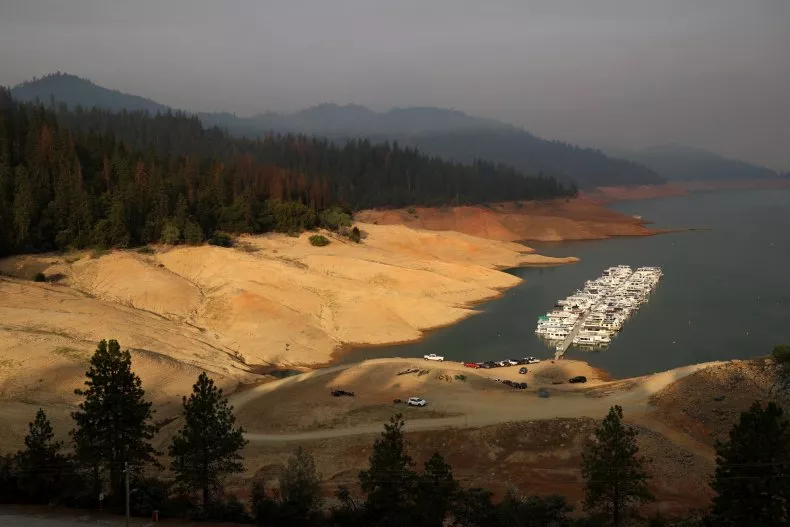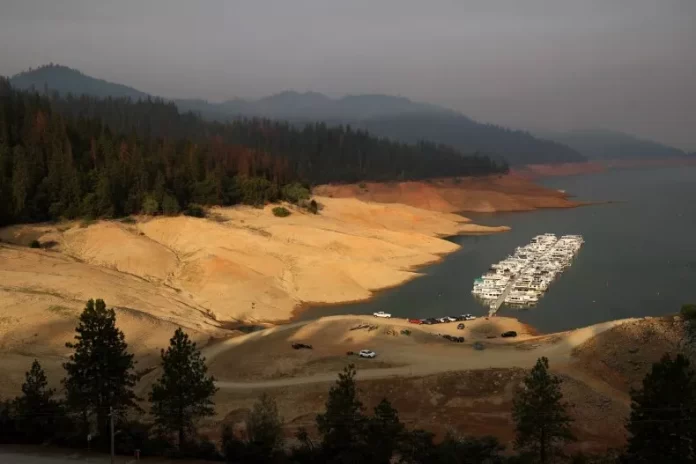California’s major reservoirs have seen significant gains in water level in recent days after two weeks of exceptionally heavy rain across the state.
It comes after months of severe drought in the region, leaving water levels in the state’s most important reservoirs well below their historical average.
“Reservoirs, mainly dams at the mountain front, provide seasonal storage for water supply, in addition to storage to reduce downstream flooding,” Roger Bales, a water and climate engineer at the University of California, Merced, previously told Newsweek.
“They store winter and spring rainfall and snowmelt [in the wet season], releasing that stored water during the summer growing season for irrigation and for municipal use [in the dry season].”

Shasta Lake
In drier years, the lakes may not reach this water storage capacity, which may place a strain on water availability for irrigation and municipal water.
In July, one-third of the total area of California was classed as under “extreme” or “exceptional” drought by the U.S. Drought Monitor.
“This year has seen the highest percentage of the country, over 80 percent of the continental U.S., be classified as being in a drought since the U.S. Drought Monitor was established a little over 20 years ago,” Antonia Hadjimichael, an assistant professor in geosciences at Penn State University, previously told Newsweek.
NEWSWEEK SUBSCRIPTION OFFERS >
The heavy rainfall currently battering the state is hoped to offset some of the effects of this year’s dry season. In San Francisco, 5.46 inches of rain fell in a single day on December 31, marking the second wettest day in over 170 years.
Some of the state’s reservoirs have seen greater water level rises than others. The state’s second largest reservoir by volume, Lake Oroville, north of Sacramento, saw water levels rise from 673 feet above sea level on December 26 to 735 feet today, January 9—an increase of 62 feet.
The state’s largest reservoir—Shasta Lake—has also seen a significant rise in water level, at 21 feet. While most of California’s major reservoirs are still below their historical averages, these increasing water levels are a good sign.
The table below shows the changes in the water level of the state’s 15 largest lakes by volume, with water level measured in feet above average sea level.
Lake Water Level (ft MSL) 12/26/22 Water Level (ft MSL) 01/09/23 Change in water level (ft)
Shasta Lake 921 942 +21
Lake Oroville 673 735 +62
Trinity Lake 2,189 2,204 +15
New Melones Lake 883 908 +25
San Luis Reservoir 412 430 +18
Don Pedro Reservoir 737 765 +28
Lake Berryessa* 394 401 +7
Lake Almanor N/A N/A N/A
Folsom Lake 386 406 +20
Lake McClure 676 735 +59
Pine Flat Lake 766 801 +35
New Bullards Bar Reservoir 1,861 1,890 +29
Diamond Valley Lake N/A N/A N/A
Lake Tahoe 6,223 6,224 +1
Lake Havasu 447 448 +1
Source: Lakes Online *Lake Berryessa data from Solano County Water Agency
More rain is expected across the state this week. However, Jeanine Jones, drought manager for the California Department of Water Resources, told the San Francisco Chronicle that, despite this significant rainfall, two weeks of wet weather were not enough to restore California’s waning water supplies.
“We need to see sustained accumulation of precipitation throughout the season,” she said. “It’s great that we’re having some storms and getting precip, but we need that to continue.”




